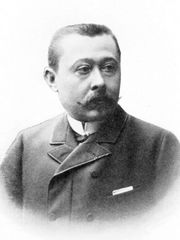
Dr. Jean Léo Testut
Jean Léo Testut (1849-1925) French physician, anatomist, historian, and anthropologist, Jean Léo Testut Deynat was born in Saint Avit Senier, France on March 22, 1849.
His early medical studies were interrupted by the Franco-Prussian war of 1870. He was awarded a medal for his courage and patriotism in this war, but declined to accept it. After the war Leo Testut finished his medical studies in 1878 at the Medical School in Bordeaux. His doctoral thesis received several awards, including the Silver Medal of the Paris Medical College.
During his medical studies at the Universities of Bordeaux and Paris, Testut was an assistant for both anatomy and physiology, eventually becoming the Chief of Anatomical Studies and Preparations in Bordeaux.
In 1887 he publishes his masterpiece: “Traité d'anatomie humaine” (Human Anatomy Treatise) in four volumes, which has a second publication in 1893.
Dr. Testut's assistant, Dr. André Latarjet (1877 – 1947) will later continue the work in this voluminous work taking it to five volumes, several editions, and translated into Spanish, German, and Italian. Smaller versions of the book as well as anatomical dissectors are published as companions to this superb book, becoming the standard of anatomical medical education in France and especially in Latin America for over 120 years.
In spite of this incredible publication, Leo Testut published well over 90 books and treatises, including an illustrated anatomical dissector. His work included anthropological research and comparative anatomy.
Dr. Testut worked as a military surgeon during World War I.
In his later life Dr. Testut received an incredible number of awards and decorations, including the Honor Legion Medal and Honorary Professor of the Lyon Medical School. He was also President of the World Association of Anatomists.
After he retired, he continued his historical studies publishing a further seven books!
Personal note: When I studied anatomy I was lucky to use the Testut and Latarjet “Compendio de Anatomía Humana”, the smaller version of the Treatise. The Treatise itself was available to us for study in the library of the Medical School at the University of Chile and I remember countless hours studying with this treasure of anatomy. Later I made it a point to own one of these incredible books, and I acquired the Spanish and the Italian version of the “Traité d'anatomie humaine”. A few years ago I added to my library a beautiful leather-bound French version of this book, which belonged to my dear friend Dr. Gonzalo Lopetegui Adams (1932 – 2004). Dr. Miranda.
Sources:
1. “Leo Testut (1849-1925)” Reverón, RR Int. J. Morphol., 29(4):1083-1086, 2011
2. “La anatomía de Testut y Latarjet” Reverón, RR R Soc Ven Hist Med (2013) 62:1; 62-72
3. “Jean Leo Testut (1849-1925): Anatomist and Anthropologist” Reverón, RR
4. “Huellas de un maestro de la Anatomía francesa: Jean Léo Testut, 1849-1925” Ledezma W.; P. Rev Inst Med Sucre LXXI: 128 (98-105), 2006



